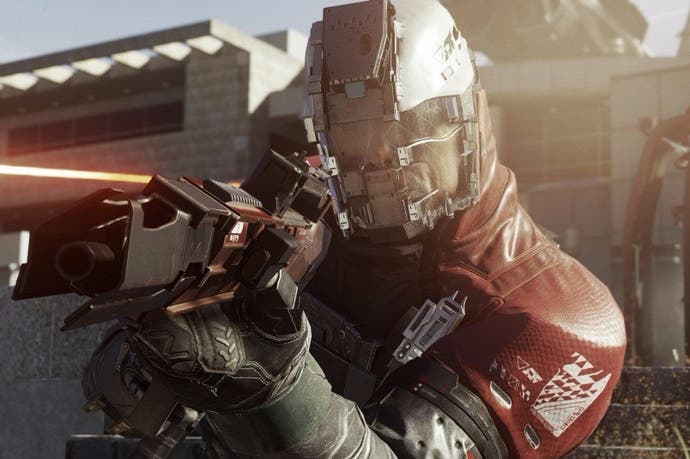Digital Foundry: Hands-on with COD Infinite Warfare on PS4 Pro
How Sony's new console takes Call of Duty into the 4K era.
PlayStation 4 Pro's enhancements for supported titles are proving varied from what we've seen so far, ranging from resolution bumps to more fine-tuned visual tweaks. Call of Duty: Infinite Warfare gave us more insight on this - the one game to demo the hardware at EGX 2016 this week. Running on a guarded row of six PS4 Pro machines, we could compare it to a similar multiplayer build running on the original PS4 - a rare chance to see the prospective gains for supported titles as we approach the new console's November 10th launch.
Between myself and colleague John Linneman, the consensus was the core visual make-up is perceptibly very close between PS4 and PS4 Pro right now, with resolution being the only enhancement. Though the maps shown on each console differed (with PS4 Pro running a neat sci-fi edition of the Terminal map from Modern Warfare 2) there's no sign yet that Sony's newer machine offers higher quality scenery or effects work while simultaneously rendering out to a 4K screen. Instead, the resolution bump is clearly the focus.
Here we saw the very same game, but rendering at a higher pixel rate to hand in a vastly clearer image. The code we saw suggests that Sony's checkerboard upscaler is in effect here. As with Horizon: Zero Dawn and other titles seen at the PlayStation Meeting, this renders out a 2x 1080p pixel count in a 2x2 checkerboard format, extrapolated out to get perceptibly close to the real deal. This can also manifest as a subtle stippling pattern on high-contrast edges in motion, difficult to pick out unless you ogle the screen closely.
This has two effects on Infinite Warfare's image quality, depending on whether the game camera is static, or if you're in motion. During rapid gameplay, its use of checkerboard rendering combines with a temporal anti-aliasing pass to produce exceptionally clean lines - and this AA method helps to disguise some of these artefacts. The downside here is that this AA also adds a faintly visible banding artifact of its own to panning shots at points. On balance though, in motion the PS4 Pro turned in a night-and-day upgrade in clarity over what we experienced on the standard PS4. The combination of sitting at a reasonable distance away from the screen combined with 4K's pixel counts makes the checkerboard artefacts very difficult to pick out visually.
The static image is even more telling. Surprisingly, a snapshot of Infinite Warfare with the game camera completely still gives us a perfect 1:1 ratio between each stair-step along an edge, and the pixels of the 4K display used to present the game at EGX. Essentially, this means any time we decide to stop moving the camera, the game starts to resolve detail at a level almost indistinguishable from a true, native 3840x2160. It's a trivial point given the fast tempo of the Call of Duty series, but an interesting sign of how the tech works, and the benefits to PS4 Pro's approach to 4K gaming.
There's another wrinkle worth mentioning. While static, Infinite Warfare also shows zero signs of anti-aliasing along geometric edges in the build we played. Despite the 4K pixel structure at these moments, there's still an obvious stair-step pattern that implies the game relies solely on temporal AA right now. The problem disappears at the first nudge of the gamepad's sticks of course, triggering these elements to smooth over again - but it'll be interesting to see if the final product ships with a more concrete solution to this.
For owners of 4K screens this is good news overall, but the enhancements aside from resolution are minimal - to the point where even the anisotropic filtering levels appeared close between PS4 and PS4 Pro, a situation that could be improved. However, the choice to simply boost the resolution is an easy show of support for the new machine - a move we're likely to see across a range of games in the near-term. As for those too strapped to shell out for a 4K TV on top of the PS4 Pro, there's still a big question mark over how Infinite Warfare benefits on standard 1080p displays - whether through a smoother frame-rate, or potentially a super-sampled, cleaner full-HD image.
As for the PS4 Pro's frame-rate in its '4K mode', one thing is clear: it's still a predominantly 60fps game, but the drops we see on the standard PS4 during explosions still persist. These are jarring lurches during the usual burst of alpha-based effects, and while this would need proper analysis when the time comes with final code, right now the performance drops on PS4 Pro are more noticeable than they are on the original PS4. The map difference between the two makes this comparison a tad unfair, but for now, we can safely say performance gains aren't readily apparent on the higher-specced hardware. Each build has issues right now.
It's a similar level of performance to the campaign snippet shown at the PS4 Pro's reveal earlier this month. Whether this is to enforce competitive parity online, between the standard PS4 and Pro crowds, is uncertain. However, the overall delivery in competitive play is strong on either machine, where the experience on PS4 Pro is designed to fit the needs of 4K adopters, no doubt eager to see their new set-ups shine.
In conclusion, what we saw of Infinite Warfare on PlayStation 4 Pro looks promising - the game is clearly very impressive visually, and it was good to get eyes-on with another title using Sony's new upscaling technology. The overall impression is that the Pro is capable of effectively making use of the extra pixel density on offer from 4K displays - it may not be a precise 3840x2160's worth of pristine detail, but it's clearly a striking upgrade over standard 1080p.



